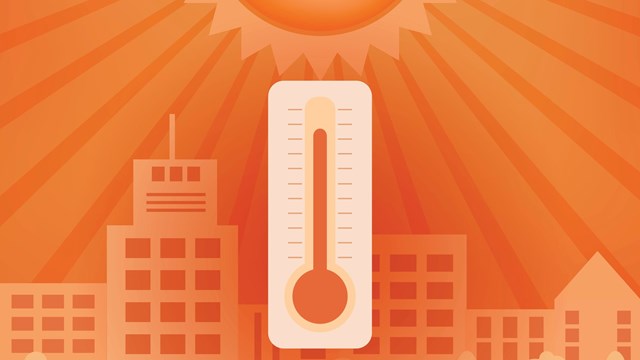In the business world, benchmarking is a management tool that is commonly used to analyze where one business stands in comparison to others in the same industry. For example, a doctor’s office might want to benchmark the practice to analyze a patient’s wait before seeing a doctor compared to the standard amount of minutes in their industry.
Measuring Energy Usage
In the property management industry, benchmarking ordinances are now being used to measure a building’s energy usage and compare it to other similar buildings. Why? Because statistics show that buildings account for about two-thirds of total community greenhouse gas production, which traps heat in the atmosphere.
In this day and age, energy is money. And in big condo buildings, energy is big money—we’re talking thousands upon thousands of dollars in waste or savings. It is very important for boards and management to understand what energy consultants are looking for within a building—and how they can work with boards and managers to suggest and implement greener, money-saving measures for buildings of every size. It's also beneficial to understand the aims of Chicago’s energy laws and what has been achieved since their adoption.
Local Laws
In September 2013, Mayor Rahm Emanuel and Chicago’s City Council adopted a building energy benchmarking ordinance to raise awareness of energy performance in its building infrastructure. The ordinance calls on existing municipal, commercial and residential buildings larger than 50,000 square feet to track whole building energy use, to report to the city annually, and to verify data accuracy every three years. The law covers less than 1 percent of Chicago’s buildings, which account for about 20 percent of total energy used by all buildings.
Improving energy efficiency is a key element of Sustainable Chicago, Mayor Emanuel’s 3-year action agenda to make Chicago more livable, competitive and sustainable. The first compliance deadline was June 1, 2014 for municipal and commercial buildings larger than 250,000 square feet.
The second group, consisting of buildings that fall between 50,000–250,000 square feet, submitted their first reports in June of 2015. Residential buildings within each of these groups of covered buildings had an additional year to comply with the ordinance, with buildings of more than 250,000 square feet first reporting in June 2015 and buildings in the 50,000-250,000 square foot range first reporting this year, 2016. Public disclosure of energy efficiency data for each group occurs until a year after the compliance date. Benchmarking, verification and reporting deadlines for additional buildings covered by the ordinance phase-in through 2016.
The Chicago Energy Benchmarking Ordinance focuses on creating information that will enable better decision-making. It does not require buildings to make any mandatory investments. The ordinance has three parts:
Benchmark energy use annually: Covered buildings will track basic building information and whole-building energy use (electricity, natural gas, and any other fuels, including common spaces and tenant-occupied spaces) using ENERGY STAR Portfolio Manager, a free online tool offered by the U.S. EPA.
Verify energy data every 3 years: In the first year in which buildings benchmark, and every third year thereafter, buildings will have energy and building data reviewed by an in-house or 3rd-party professional with a license or training credential recognized by the city.
Report to the city annually: through the through ENERGY STAR Portfolio Manager and follow the prompts to send benchmarking data to the City of Chicago no later than June 1st.
In 2015, there were 2,122 covered properties located throughout Chicago’s 77 neighborhoods. In all 1,774 properties complied, submitting reports or receiving temporary exemptions. Overall, there was a reporting rate of 84%, representing 92% of covered square footage. Seventy-seven percent of analyzed properties received an ENERGY STAR rating which is provided on a scale of 1-100 with 50 indicating the national median level of energy performance and 100 indicating extremely high performance. The Chicago median ENERGY STAR score was 58 for all building sectors, 16% higher than the national median.
Compliance & Incentives
Chicago adopted the building energy benchmarking ordinance to raise awareness of energy performance through information and transparency, with the goal of unlocking energy and cost-saving opportunities for businesses and residents.
“Chicago has become a global leader. Particularly in the scope of clean energy and clean tech,” Chris Wheat, chief sustainability officer for the City of Chicago told Sustainable Chicago Magazine in March 2016. He views Chicago’s Energy Benchmarking program as a great success. “Even some of the organizations that pushed back on the initial ordinance have actually become partners in regards to outreach. Folks like BOMA/Chicago and the Chicagoland Apartment Association (CAA) have been really good partners and make sure that their members are well aware of the ordinance and encourage them to comply.”
The City of Chicago offers support to building owners which includes comprehensive notification, outreach and guidance materials, free training on the ordinance and reporting tool, access to whole-building utility energy data at no cost (so covered buildings won’t have to request individual occupant data), pro bono data verification for buildings experiencing financial need, local energy efficiency funding and support for energy benchmarking and efficiency improvement through the U.S. EPA’s Energy Star program.
Wheat himself is very hands on. “A lot of my initial work around energy here in the mayor’s office was just spending time with those landlords and hearing about their concerns,” he told Sustainable Chicago Magazine. “We know that a lot of these are entrepreneurs, they’re mom-and-pops who are really just trying to make a dime and they’re not energy experts. So what are we doing to make sure that we make this simple and plain to them, making sure they understand what they can do with this information?”
A Case in Point
In 2007, the state of Illinois passed legislation requiring energy utilities to set aside ratepayer funds to invest in energy efficiency. The resulting incentives expand opportunities for buildings to pursue subsidized energy efficiency improvements that save money and energy. There are ComEd and People’s Gas’ Multi-Family Comprehensive Energy Efficiency Program, which offers technical support and incentives for residential building managers and owners. DRF Trusted Property Solutions in Plainfield, Illinois, also has its own Resource Conservation program, to help buildings save money on their energy costs.
Though a rental not a condo, Astoria Towers represents a good case study on what can be achieved when ownership uses information gathered as a result of the sustainability programs to improve its energy footprint. Using Peoples Gas Free Energy Assessment Services, the ownership undertook changes that reduced energy use by 7,752 therms and 220,905 kWh and saved 1,266,580 gallons of water, which translated to $49,000 in savings.
DRF, in combination with Peoples Gas, earned the largest single rebate for a multifamily project in the program’s history, when it replaced the boilers at the 552-unit Chatham Park Village Cooperative on Chicago’s South Side. The co-op had high energy costs because the boilers and commercial water heaters were operating below 70% efficiency, according to the case study on the project. When the custom-engineered solution by DRF was installed, savings were immediate. This project, DRF said, yielded actual first year therm savings of 416,846—158.8% over projection. Actual first year gas savings was an incredible $345,656—126.9% over projection.
Individual residential energy efficiency incentives include Retrofit Chicago’s Residential partnership, which provides support and resources to help Chicago residents reduce utility bills and increase home value through energy efficiency. Programs include help finding a trusted contractor who will conduct a comprehensive energy assessment to identify how your home uses and wastes energy while pinpointing the most cost-effective improvements, free energy saving items, including programmable thermostats and showerheads, and rebates on qualifying air conditioners, furnaces and other large appliances.
Professional Help
For many buildings, it makes more sense to hire an energy consultant than to take the do-it-yourself route. “This is the way you can get the best energy saving plan for the building,” says Dumitru Nicoleascu, a partner at Green Attic Insulation, an energy services company in Chicago.
“Your energy adviser will help build and manage a specific energy cost management strategy, along with a customize rebate application for the improvements to be made for the building.”
Instead of picking and choosing random energy improvements that the board or manager has a feeling may be right for the building, a professional energy consultant will go in with the proper tools and expertise, and then collaborate with building or association administrators to implement a fully informed game plan. “We have an individual approach for each customer, because each and every one of them have specific needs and predetermined conditions,” Nicoleascu says, explaining that this takes between two and five hours per building.
Nicoleascu’s toolbox includes IR cameras, a combustion analyzer, moisture meters, blower door, digital pressure and flow gage, gas leak detector, carbon monoxide detector, fiber optic borescope, laser tape measure and a wizard stick smoke detector. “We will calculate potential estimated electricity saved per year (kWh), estimated natural gas savings per year (therms), and blower door CFM50 reduction,” Nicoleascu says. After all the work is done and all improvements were made, the customer will receive an Illinois Home Performance (IHP) certificate, he says. The certificate gets included in MLS listings, and has been proven to raise home value, Nicoleascu says.
He also noted that the technology used to measure energy usage, in particular the Blower Door Test, works best in single family home environments as the entire housing unit is self-contained. When conducting tests in condominium units there can be some variation in results due to heat flow between apartments. This effect is minimal in two story “townhouse” type units and more pronounced in “high-rise” style multi-family buildings. The good news is that the test can detect heat loss to your neighbors unit. In the case of individually heated units where the owner is responsible for heating costs directly that’s a good thing to know.
Worth the Price
Before choosing an energy consultant, Nicoleascu suggests making sure that they are Building Performance Institute (BPI) building and envelope-certified, and a member of the Midwest Energy Efficiency Alliance (MEEA). The company should be an IHP approved contractor, and an EnergySmart and Energy Impact Illinois-certified contractor. “Any extra certification is a plus, as well as radon certified, and lead certified, etc.,” Nicoleascu adds.
Hiring an energy consultant isn’t just good for resales. It can also bring down the costs within the entire building. For example if a condo association is paying for hot water for the whole building, and expenses can be reduced through findings from an energy consultant’s work, the condo association might be able to reduce the condo association fee. A qualified energy consultant may be able to redesign buildings’ mechanicals so that owners provide their own heat rather than buildings. Energy reports help with air service issues within the building. When leakage is identified a building can keep air-conditioning or heat inside a unit—along with cigarette smoke. For this type of service, an individual unit typically pays $300-$500, while an association will pay about $2,000 per day.
Anyone with questions about the process may contact the Chicago Energy Benchmarking Help Center, which provides phone and email support: 855-858-6878, info@Chicagoenergybenchmarking.org.
A.J. Sidransky is a novelist and a staff writer for The Chicagoland Cooperator and other publications.







Leave a Comment